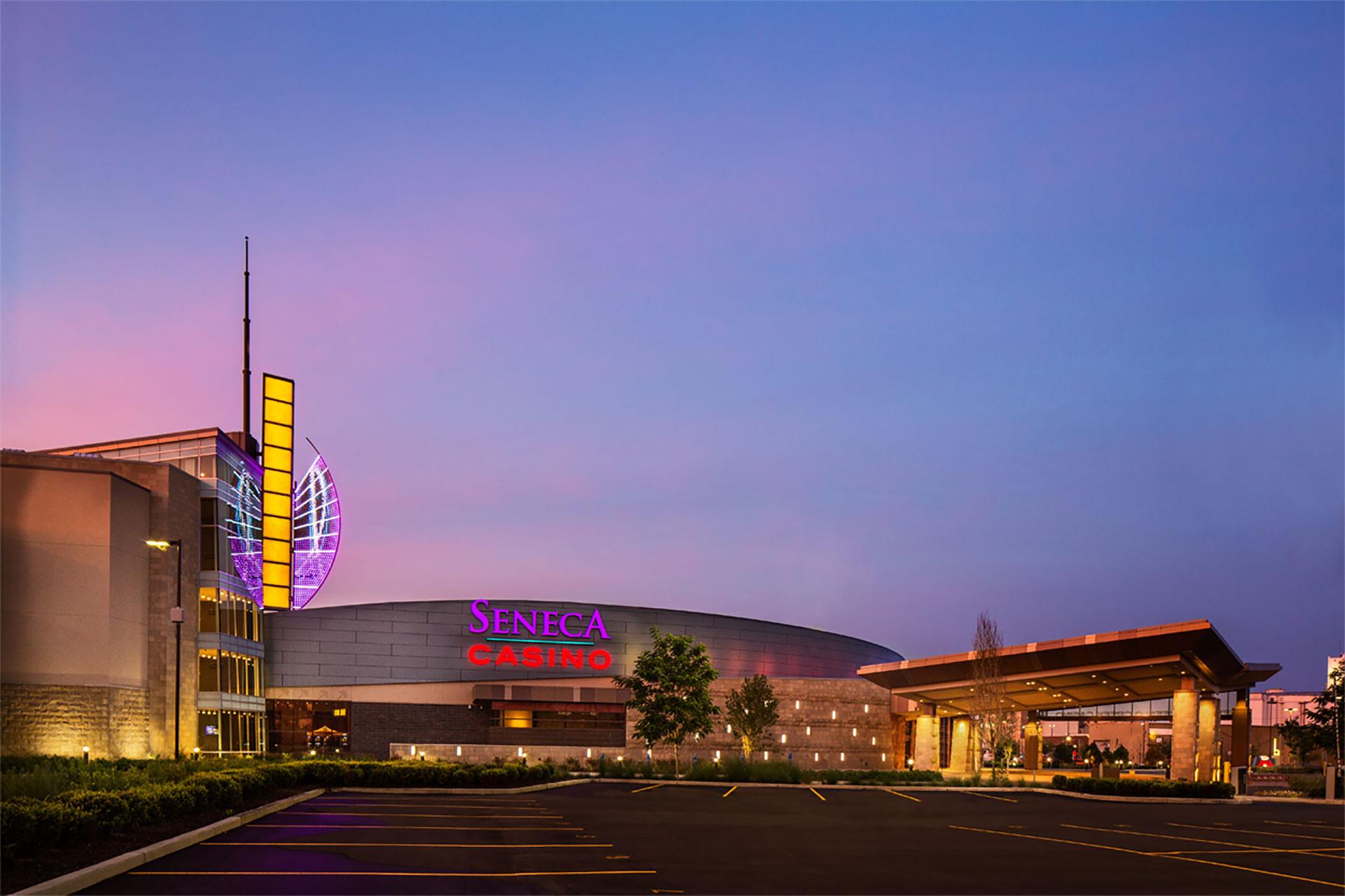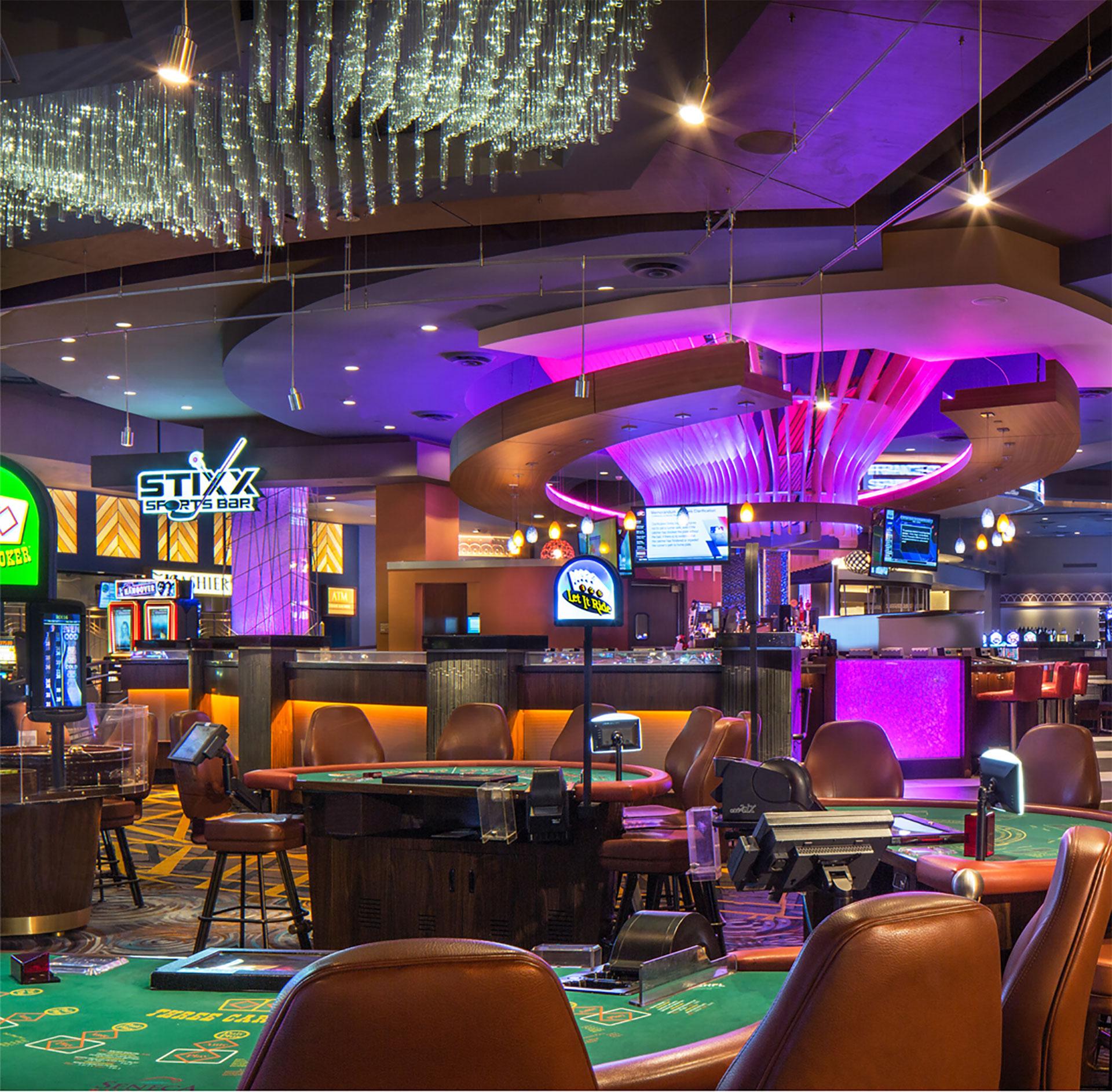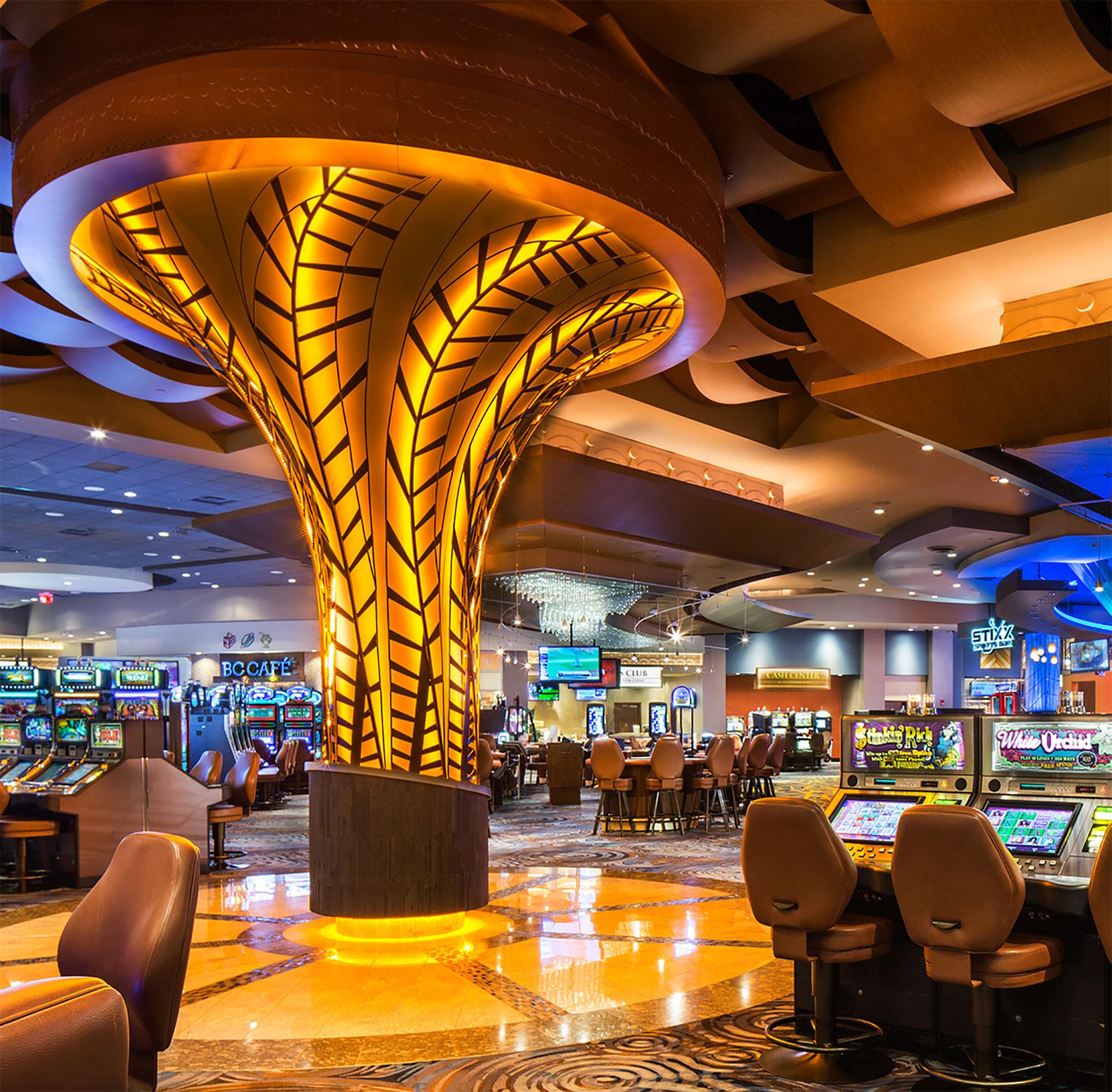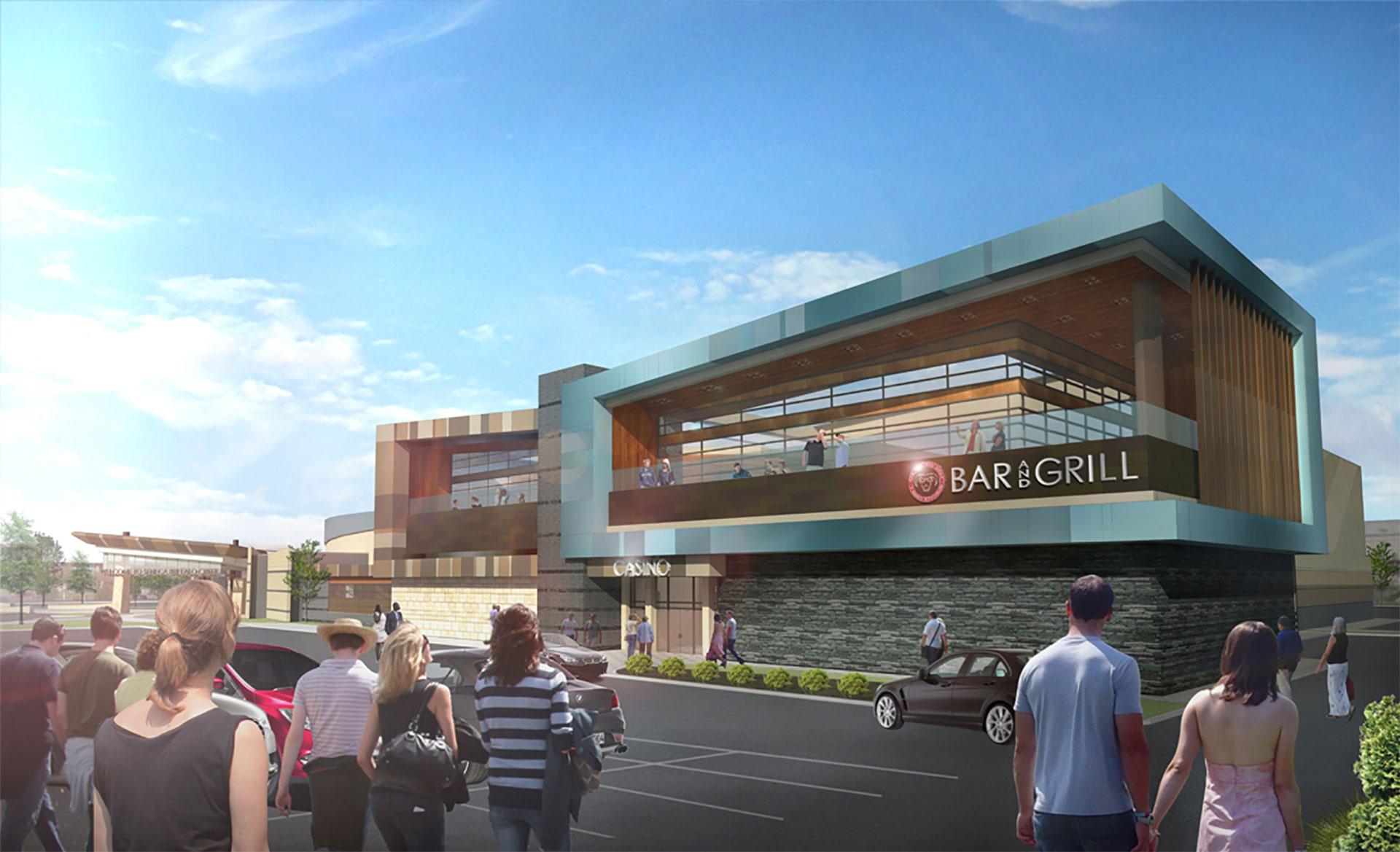Case studies on Native American casino resort designs
Gaming resort architects strive to integrate important tribal symbols and patterns wherever possible when it comes to designing the latest Native American casino resorts, as these case studies from leading firms show.
CASE STUDY 2
Seneca Buffalo Creek Casino
Location: Buffalo, N.Y.
Owner and operator: Seneca Nation, New York
Architect: Hnedak Bobo Group (HBG)
Opening Date: 2013 (expansion to open spring 2017)
The Seneca Buffalo Creek Casino adds unmistakable energy and excitement to the Inner Harbor area of downtown Buffalo, N.Y., an area of the city that is now seeing resurgence in development, partially due to the Seneca Nation’s long-time commitment to area growth.

With an architectural and interior design by HBG (Hnedak Bobo Group), the urban casino is uniquely positioned in location, size and amenities to meet the needs of the regional gaming and entertainment market as it advances the Seneca Nation’s culture and community vision.
That vision involves creating a modern economic development that stimulates and creates synergy as part of the restaurant, retail and entertainment renaissance happening in the Buffalo Inner Harbor District.
The Seneca Nation has strong historic and cultural ties to the Inner Harbor area—which falls within their ancestral nine-acre sovereign Buffalo Creek Territory; the property’s owners strongly believe that the success and growth of the Buffalo Creek gaming operation and the success and growth of the surrounding district go hand-in-hand. This vision of community integration directly influenced the casino design—of both the phase I casino, and now the phase II expansion scheduled to open spring 2017.

Marrying community and culture, the property’s carefully-planned design by HBG takes cues from its location just two blocks away from the First Niagara Center, home of the NHL’s Buffalo Sabres hockey team, the strong regional water influences of adjacent Lake Erie and Buffalo River/Buffalo Creek, and meaningful cultural elements significant to the Seneca Nation. The subtle, physical interpretation of these elements results in a contemporary and vibrant experience true to the Inner Harbor’s context and planned development trajectory.
EXPANDED APPROACH
Upon the permanent casino’s opening in 2013, the property witnessed tremendous success, leading the Seneca Nation to announce an expansion in 2015, consisting of new restaurant and gaming amenities.
In January 2016, the Seneca Nation and Seneca Gaming Corporation broke ground on the $40 million expansion project, also designed by HBG. As reported by the nation, the economic impact is expected to be large, with approximately 800 people working at Seneca Buffalo Creek Casino, helping to entertain the more than three million annual visitors.
Currently under construction, the two-story addition to the existing casino adds approximately 28,500 square feet of space on each of two levels. The ground floor will add more than 300 additional slot machines and additional table games, including a high limit room and expanded non-smoking area, and a performance stage for live entertainment at Stixx Sports Bar. The second floor of the expansion will introduce a new ‘Western Door Steakhouse’ concept restaurant with indoor and outdoor seating.
“Design and economics go hand-in-hand,” said Paul Bell, AIA, project manager and principal at HBG. “It was important hat, as designers, we understood the market influences at play in the Inner Harbor district before we began formulating ideas.” For example, according to industry research, HBG knows that today’s consumer, no matter their age, from Millennials to Boomers, expects more for their money—more creativity and intelligence from their entertainment experiences, more relevant amenities, more authenticity, more distinction.
“These aspects influence how guests spend their entertainment dollars,” Bell added. “We need to elevate our design thinking for each project and get very targeted with amenity design and offerings.”
Buffalo’s Inner Harbor market was primed for new, targeted experiences. Three main design elements/venues at the Seneca Buffalo Creek Casino fulfilled a market gap. Spurred by community-driven interests and a focus on locality and authentic elements of native and regional design, designers created the Stixx Sports Bar and the Western Door Steakhouse restaurant, and infused the casino with subtle references to Seneca Nation heritage, culture and local context.
TRIBAL VOICE
To get the heritage angle correction, HBG worked closely with Seneca Nation stakeholders, Seneca Gaming Corporation leadership and casino operations, and Seneca Construction Management Corporation. From early design and cultural exploration workshops through to construction, the Seneca Gaming Corporation leadership is highly involved in keeping the team focused on realizing the ultimate project vision.
Close collaboration between HBG’s design team and the Seneca Nation Cultural Committee was invaluable to ensure authenticity of native artwork and regional inspirations, including custom materials used throughout the design.

“Before design concepts were created, our team met with the Seneca Cultural Committee to learn about the nation’s customs, history and cultural identity,” said Nathan Peak, AIA, design discipline director and principal at HBG. “The nation wanted the property to reflect the local Buffalo area, while also infusing meaningful cultural elements into the design.”
One such cultural element worked into the property’s design was the Seneca Walk. “As a unique place making element, the Seneca Walk was created as a signature pedestrian entryway to the property,” Peak said. Stretching from the corner of Perry St. and Michigan Ave. to the casino’s front door, Seneca Walk is lined with eight custom-lit pylons, each representing one of the eight Seneca tribal clans—Turtle, Bear, Wolf, Beaver, Snipe, Heron, Deer and Hawk.

The Senecas are also known as the “People of Great Hill.” This historical and cultural element inspired designers to plant a White Pine, symbolic of the Tree of Peace, on the 10-foot hill overlooking Seneca Walk. The glowing Tree of Peace landmark design element is unmistakable on the casino floor, a welcoming and energizing feature that also works to make wayfinding easy and uncomplicated for casino guests. The Tree of Peace becomes a focal point of the design, highlighted by an undulating wood-tone ceiling.
Rising almost 17 feet in height and spanning almost 14 feet at its widest point, HBG’s design of the Tree of Peace is highly abstracted; sculptural pine branches rise up around the tree to emphasize the rhythm and geometry of the individual pine needles. Illuminated to signify its importance, the Tree of Peace is said to have been “used by the Creator to represent peace, strength, the will to not fight against one another and protection when abiding by the great law of peace.”
The Seneca Nation is also widely recognized for their intricate jewelry and beadwork patterns. Metallic canopies found over many of the public spaces feature patterns derived or abstracted from traditional Wampum belt patterns unique to Seneca. The Hiawatha belt, which memorializes the Great Law of Peace, can be found over all entrances of the casino. Distinctive floral, ribbon and 3D splint-and-ash basket weave motifs layer on ceiling, wall and floor coverings, while Seneca artwork features rosette medallions and stainless steel panels. The high-limits gaming area is set apart by mosaic flooring made of Sicis art glass and marble mosaics that provide a wonderful iridescent visual effect–reminiscent of traditional Seneca Nation jewelry.

Drawing inspiration from Lake Erie and Buffalo Creek, designers applied a symbolic water design to the building’s façade with blue metal panels creating a visual wave-like movement spanning the casino entrance and wrapping around the building. The blue panels are continued into the two-story expansion elevation to emphasize the rectangular geometry and a second story balcony for outdoor Western Door Steakhouse restaurant dining. This water concept was carried into the gaming floor by a custom carpet pattern resembling radiating water droplets, and in fluid-patterned blue and multi-colored carpet detailing on the expanded gaming floor.
Internally, the two-story expansion adds a new central stair with a dramatic overhead ceiling and wall feature evocative of a long, flowing waterfall lit in deep shades of watery blue and gray. The new design element will add to the gaming excitement and give the new expansion an interior prominence on par with its elevated exterior stature. A second main bar will be located on the new gaming floor underneath the new stair, accented by water-inspired hues and rain-like ceiling light features that frame the bar seating area.
FACING CHALLENGES
As with any property built close to water, Seneca Buffalo Creek Casino has a bunch of unique developmental obstacles to overcome. A key challenge early on involved how to most effectively integrate the property on the site for visibility and accessibility from main Inner Harbor district traffic. This involved forecasting where future development might take place in the district so that the Seneca Buffalo Creek Casino remains an active contributor to the area’s economic development as sprawl naturally occurs in the district.
Designers took the project’s site planning very seriously, since placement of the main entry and access to key community–based amenities would greatly affect the success of the overall development. The first phase implementation created a unique place making element, the Seneca Walk, as a signature pedestrian entryway to the property that also sets the tone for future development.
Memphis, Tenn.-based Hnedak Bobo Group (HBG) is a national leader in the design of casino resorts. For more information on the company, visit hbginc.com.
